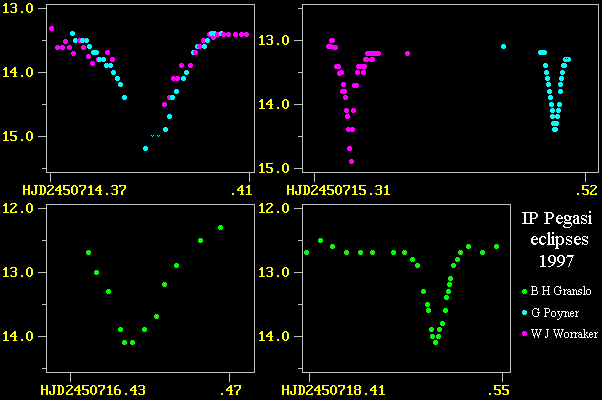Eclipses of this star can be observed in all stages of its outburst light cycle and can provide key information to astrophysicists seeking to understand the dwarf nova outburst mechanism. Eclipses occur when the secondary star in the system orbits in front of the white dwarf primary star, accretion disc and hot spot (which is due to the impact of the gas stream from the secondary on the outer edge of the accretion disc). Eclipse light curves are therefore affected by the changes in the accretion disc which give rise to outbursts and thus, taken together over the course of an outburst, can help elucidate the outburst mechanism.
Sample eclipse light curves from the 1997 September outburst are shown below. An ephemeris for mid-eclipse times through the 1999 observing season is also given here as an observers' guide. This is geared to observers in the United Kingdom. Alternative ephemerides for other parts of the world can be supplied on request. As can be seen from the ephemeris given here, the best time of year for observing runs of an hour or more on IP Peg is August-October. There is usually one outburst of IP Peg each year over this period. If you wish to be notified as early as possible of an outburst and do not normally receive VSNET or AAVSO variable star alerts, you may e-mail Gary Poyner or myself to register your interest in advance.
Eclipses in IP Peg can last for an hour or more. Light variations in the last 1-1.5 hours before an eclipse, which often show an "orbital hump" (a slow increase in light level of up to 1 magnitude due to the hot spot moving to face the observer), provide valuable data in addition to the eclipses themselves. Thus observations can usefully start up to 2 hours ahead of predicted mid-eclipse, and should be continued at least until the eclipse is evidently over, preferably longer; starting only half an hour ahead of mid-eclipse means losing valuable data.
Visual observers using telescopes in the 25-40cm aperture range should be able to cover most eclipses (down to minimum light) which occur during outbursts of IP Peg, apart possibly from those in the very early or very late stages when minimum light falls well below magnitude 15 visual. In order to follow the rapid light changes which occur during eclipses estimates should be made as frequently as possible without sacrificing accuracy. A useful guideline rate is 1 estimate per minute. The time of each observation should be recorded as accurately as possible; with modern electronic timepieces an accuracy of 1-2 seconds is not difficult to achieve.
It is recommended that observers use a well-known comparison sequence when making and reporting their estimates. The charts available with these pages (BAA reference 186.03 A | B | C) are suitable for observers either working visually or using CCDs with V-band filtering.
BAA reporting practice for variable star estimates is always to quote the instrument used, time, sequence and comparison star, method (Pogson or fractional), actual estimate and a note of any adverse conditions (e.g. cloud, moonlight) as well as the reduced magnitude. Omission of any of this information reduces the scientific value of the estimates. However visual estimates can suffer from bias and other subjective errors, and the smallest error which can be expected in ideal circumstances is +/-0.1 mag. Hence although visual results can be used to determine the width, depth and main features of eclipses they are inadequate for professional light-curve analysis. For this purpose CCD photometry is required.
V-filtered CCD observations made at a rate of about 1 frame per minute or faster (obviously depending on the exposure time and camera dead time) are particularly valuable. The V-filtering is necessary to ensure that results obtained using different cameras are comparable and can be expressed in terms of a recognised photometric waveband. Although V-filtering reduces the effective aperture of a telescope/camera system and therefore demands increased exposure times for the sake of an adequate signal-to-noise ratio, experience has shown that when IP Peg is in outburst amateurs can nevertheless produce results at a useful rate with a V-filter in place. The best comparison star for IP Peg when making V-band photometric measurements is G1716-2348, about 37 arc seconds NE of the variable; it is marked as star B on the BAA chart. Its relative brightness helps to reduce the overall error in deducing V magnitudes for IP Peg from differential photometry.
CCD photometry obtained by Nick James are on The Astronomer IP Peg page.

For further information contact: Bill Worraker or Gary Poyner.
For advice on CCD observations of IP Peg, contact Nick James.
Results can be sent either to Bill Worraker or to Dave McAdam, BAAVSS secretary.
Discovery as a variable: Lipovetskij V.A. and Stepanyan J.A., Astrofisika 17, p. 573, 1981.
Discovery as an eclipsing dwarf nova: Goranskij V.P., Shugarov S.Yu, Orlowsky E.I. and Rahimov V.Yu, IBVS No. 2653, 1985.
Orbital period: 3.80 hours
Outburst interval: 95 days average, with considerable variations.
Range of variation: Magnitude 12-18 visual. In normal quiescence outside eclipses the visual magnitude is around 15-15.5, the variation being due to the large orbital hump of the system. The eclipse depth is then 3 magnitudes. In outburst the visual magnitude range outside eclipses is 12-13.5, eclipses being typically 1.5-2 magnitudes deep except at the very beginning and end of an outburst when they are deeper.